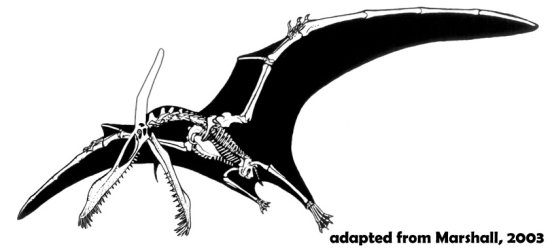Meaning
Caulk Head
(slang term for Isle of Wight residents)
Wingspan
Unknown
Classification
Pterosauria,
Pterodactyloidea.
Ornithocheiridae Seeley, 1870.
Caulkicephalus trimicrodon Steel, Martill, Unwin and Winch, 2005
Locations
Sandown
A pterodactyloid, Caulkicephalus has no tail, but does have a mouth full of teeth, possible used to catch fish while in flight. Not only does it have a keel-like crest on its beak, but it also had a Pteranodon-like crest at the back of its head.
Although the new Isle of Wight specimen is not as complete as the best Brazilian specimens, it has a unique tooth configuration and represents an entirely new kind of ornithocheirid. Caulkicephalus is known from six pieces of skull, three of which fit together to form the anterior of the rostrum. The rest being the braincase, a quadrate and a jugal. There are also some postcranial elements – parts of the first, second and third phalanges. No teeth were found.
The alveoli of the rostrum vary in size, 1-4 and 8-10 being relatively large. The third pair is the largest, followed by the second. The first four pairs of large alveoli are followed by three very small alveoli (5-7). Posterior to these are a further three large alveoli, and after this point the specimen is broken. Alveoli 9 and 10 are staggered, rather than parallel. Within alveoli 1 and 9 on the right side there are replacement teeth emerging. The teeth are oval in cross-section. The anterior tip of the palate curves gently upwards at alveoli 1 and 2, at an angle of around 45 degrees. The palate has several foramina between the first four pairs of alveoli. They tend to be paired, and linked by a 5-6mm long groove. There is a small pit just posterior to the right alveolus that may be a nutritive foramen, but could be a pathological feature or even more recent damage. The maxillopremaxillary suture has a slightly posterior descent.
The median palatal ridge is not very pronounced, and is invisible in lateral view, and becomes even less pronounced toward the anterior, disappearing between alveoli 8 and 9.
The specimen has no premaxillary crest, but there is evidence that it has broken off. There was a parietal crest at the posterior of the skull, but much of this is missing, and consists of two thin sheets of compacta separated by a system of fine trabeculae. These crests were not connected.
Material is rare, so please report it if you find some…




